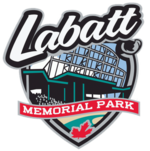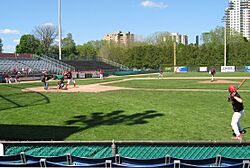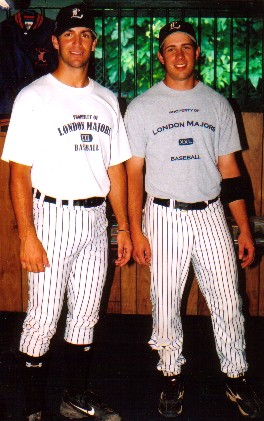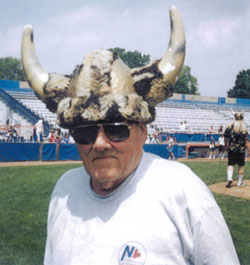Labatt Park facts for kids
 |
|

The park during a game in 2010
|
|
| Former names | Tecumseh Park |
|---|---|
| Location | London, Ontario, Canada |
| Owner | City of London |
| Capacity | 5,200 |
| Field size | 330 ft (100 m) down the lines; 402 ft (123 m) to centre field |
| Surface | Grass |
| Construction | |
| Opened | May 3, 1877 |
| Renovated | 1883, 1937, 1950s (side stands), 1989 (added more side stands), 2001 |
| Construction cost | 2000 (new Grandstand): $1.97-million |
| Architect | Tillman Ruth Mocellin |
| Tenants | |
| London Tecumsehs (IA) (1877–1878; 1888–1890) London Alerts (1897, 1899) London Cockneys (IL) (1899, 1908) London Cockneys (CL) (1911) London Tecumsehs (CL) (1912–1915) London Tecumsehs (M-OL) (1919–1924) London Indians (M-OL) (1925) London Majors (IBL) (1925–present) London Tecumsehs (OL) (1930) London Pirates (PONY League) (1940–1941) London Tigers (EL) (1989–1993) London Werewolves (FL) (1999–2001) London Monarchs (CBL) (2003) Western Mustangs (OUA) (2006–present) London Rippers (FL) (2012) |
|
Labatt Memorial Park is a famous baseball stadium in London, Ontario, Canada. It's located near the Thames River. The park is about 8.7 acres in size and has 5,200 seats. It has a natural grass field. From home plate to center field, it's 402 feet, and to left and right field, it's 330 feet.
This park is known as the "oldest continually operating baseball grounds in the world." Its history goes all the way back to 1877. Since 1936, the City of London has owned Labatt Park. Today, it's home to the London Majors of the Intercounty Baseball League and the Western Mustangs baseball team.
Contents
- Early Days of Baseball at the Riverforks
- The London Tecumsehs Baseball Club
- Park Changes After Floods
- Negro League Players and Other Stars
- Bryce's Early Baseball Guides
- Tecumseh Park Becomes Labatt Park
- London's Major League Stars
- Women's Baseball and Army Teams
- Famous Pitchers: McLain and Jenkins
- Professional Teams in Recent Decades
- A Busy Place for Many Activities
- Roy McKay Clubhouse
- Labatt Park Reunion in 2005
- "Got Milk?" Commercials Filmed Here
- Baseball Day in London, 2006
- "Oldest and Continually Operated" Park
- Images for kids
Early Days of Baseball at the Riverforks
Before it became Tecumseh Park in 1877, the area where Labatt Park now stands was likely a grassy common space. People probably used it for fun games. Baseball's beginnings in this area are quite old. The game, which came from the British game of rounders, might have arrived from nearby Beachville, Ontario. The first recorded baseball game in the world was played there in 1838.
The London Tecumsehs Baseball Club
The London Tecumsehs Baseball Club started in 1868. This led to the creation of Tecumseh Park in 1877. The very first game at the new park was on May 3, 1877. The London Tecumsehs played against their junior team, the London Atlantics. The Tecumsehs won the game 5-1.
Newspaper reports from that time said the new grounds were "the most complete" in Canada. They even said few American cities had such a good playing field. On May 4, 1877, the Tecumsehs played their first International League game against the Hartfords of Brooklyn.
On May 24, 1877, a huge crowd of 8,000 fans watched. The National League champions, the Boston Red Stockings, played the London Tecumsehs. London's star pitcher was Fred Goldsmith. Boston won a close game, 7-6.
W. J. Reid, a china merchant from London, created Tecumseh Park. He named it after Tecumseh, a Shawnee Chief. Chief Tecumseh fought alongside the British in the War of 1812. He died in the Battle of the Thames in 1813.
Jacob Englehart, a future vice president of Imperial Oil, was the Tecumsehs' president. He brought the team to Tecumseh Park in 1877. Englehart looked for professional players from the U.S. He signed four Americans, including pitcher Fred Goldsmith. Many believe Goldsmith helped invent the curveball.
In 1877, the Tecumsehs played in the International Association. This league was a rival to the National League. That year, the Tecumsehs beat the Boston Red Stockings in an exhibition game. Later, they won the International Association pennant by beating the Pittsburgh Allegheny 5-2. More than 6,000 people watched this championship game. The park was originally built to hold only 600 people!
After the season, the Tecumsehs were invited to join the National League but said no. The team later stopped playing in 1878 due to money problems.
The Tecumsehs also played at the park before and after 1920. Charlie Gehringer, who later became a star for the Detroit Tigers and was inducted into the Baseball Hall of Fame, played for the 1924 London Tecumsehs.
Baseball historians Bill Weiss and Marshall Wright listed the 1920 London Tecumsehs as one of the Top 100 Minor League Baseball Teams of all time. They had an amazing record of 86 wins and 32 losses.
On September 15, 1920, Ty Cobb played at Tecumseh Park. His Detroit Tigers beat the London Tecumsehs 5-4 in an exhibition game. The 1920 Tecumsehs won their league pennant with 15 games left to play. London also led the Michigan-Ontario league in attendance, with over 100,000 people watching them play.
On May 9, 1921, the Pittsburgh Pirates, managed by George Gibson, played the London Tecumsehs. The Pirates won 8-7 in an exhibition game. Gibson even caught the first inning with his 1909 World Series-winning teammate, Babe Adams.
On September 14, 1921, the Tecumsehs won the Michigan-Ontario Baseball League championship. They beat Bay City, Michigan, 1-0 at Tecumseh Park. London's pitcher, Frank Herbst, was incredible. He allowed only six hits and one run in 33 innings during the series.
On September 28, 1921, London won the best-of-seven series against Ludington, Michigan, 4-3. They won Game 7 by a score of 10-7.
On May 23, 1923, famous pitcher Walter Johnson was at Tecumseh Park. He was in uniform but did not pitch as his Washington Senators beat the Tecumsehs 13-9 in an exhibition game.
Park Changes After Floods
A flood from the Thames River damaged Tecumseh Park on July 11, 1883. The original grandstands were destroyed. Home plate was moved to its current location. A new grandstand was built facing east.
Starting in 1892, the park was also used for bicycle races. Famous international riders like Harley Davidson competed there. Baseball continued to be played, too. In 1895, the park even hosted the first-ever motion picture display in London.
The London Cockneys played in the park in 1908 and 1911. Another Tecumsehs club played from 1912 to 1915. During this time, Earle Neale played baseball at Labatt Park. He later became a professional football coach.
The Tecumsehs played in the Michigan–Ontario League from 1919 to 1924. Charlie Gehringer played for them in the early 1920s. He and the Tecumsehs even beat the Boston Red Sox in an exhibition game in 1921.
In 1940 and 1941, the London Pirates played in the PONY League. During this time, lights were installed at Labatt Park. This allowed night baseball games to be played.
Negro League Players and Other Stars
In the first half of the 1900s, Labatt Park often hosted "barnstorming" teams. These were teams that traveled around playing exhibition games. Many Negro leagues teams from the U.S. visited. A very famous visit was by legendary African-American pitcher Satchel Paige on June 30, 1954. Paige was touring with a baseball version of the Harlem Globetrotters. He pitched in an exhibition game against the House of David baseball team.
After the Negro Leagues gradually ended, many former players joined the Senior Intercounty Baseball League. These players made many appearances at Labatt Park in the 1950s. They included pitchers Ted Alexander and Wilmer Fields, and players like Jimmy Wilkes and Stanley Glenn.
Bryce's Early Baseball Guides
In 2002, important information about early Canadian baseball was found. Library and Archives Canada bought Bryce's Base Ball Guide 1876 and Bryce's Base Ball Guide 1877. These small, hand-colored books were published by William Bryce of London, Ontario. They are considered the first major publications about Canadian baseball.
William Bryce was a bookseller and sporting goods seller in London. He had a small share in the Tecumsehs team. During U.S. President George W. Bush's visit to Library and Archives Canada in 2004, he showed special interest in these old baseball books.
Tecumseh Park Becomes Labatt Park
The park was damaged again by a big flood in 1937. This flood led to the building of the park's third grandstand. The local Labatt Brewing Company donated $10,000 to help fix the park. They also gave the park to the City of London on December 31, 1936. They asked that the park always remain a public athletic park and be renamed "The John Labatt Memorial Athletic Park."
Changing the name from Tecumseh Park to Labatt Memorial Park showed a shift in Canadian society. It moved from a time when figures like Chief Tecumseh were honored to a more modern era where businesses like Labatt had a big influence.
In the 1950s, Labatt Park hosted the "Junior Olympiad" every year. Athletes from across the city competed in various sports during this two- to three-day event.
London's Major League Stars
Two other London baseball players who made it to the Major Leagues from Labatt Park in the 1940s were Tom (Tim) Burgess and Frank Colman.
In 1936, Frank Colman started playing at Labatt Park for the London Winery team. He won the Most Valuable Player award and the batting title. Colman joined the Pittsburgh Pirates in 1942. He played for them until 1946, then moved to the New York Yankees in 1946 and 1947. He even shared a room with Yankee catcher Yogi Berra.
Colman returned to London in 1954. He bought the London Majors team. As a player and owner, he won the Intercounty League title in 1956. Colman also helped start the Eager Beaver Baseball Association (EBBA) in London in 1955. This league has provided competitive play for thousands of young baseball players. In 1984, a year after Colman passed away, the EBBA's all-star day was renamed "Frank Colman Day."
Frank Colman was inducted into the Canadian Baseball Hall of Fame & Museum in 1999. He also joined the London Sports Hall of Fame in 2005. Yogi Berra, a famous baseball player, wrote that he was proud to be Frank's friend.
Tom Burgess signed his first professional contract in 1946. He played for the St. Louis Cardinals from 1954 to 1961. He also played for the Los Angeles Angels from 1962 to 1963. After his playing career, Burgess worked in Major League Baseball as a manager, coach, and instructor for many years. He was inducted into the Canadian Baseball Hall of Fame & Museum in 1992.
Women's Baseball and Army Teams
During World War II (from 1942), Labatt Park was home to several women's baseball, softball, and fastball teams. This included the London Supremes. In 1943 and 1944, the London Army Team won the Canadian Sandlot title.
After World War II, the London Majors won the Canadian Sandlot Congress in 1947. They also won the Can-Am Baseball Congress championship in 1948. They beat the Fort Wayne General Electrics in a seven-game series at Labatt Park.
Famous Pitchers: McLain and Jenkins
In 1974, after winning the Cy Young Award twice, pitcher Denny McLain played for the London Majors. He mostly played in home games at Labatt Park. Due to arm problems, he pitched only nine innings. However, he played in 14 games at other positions and batted well.
After his final Major League game in 1983, Fergie Jenkins was convinced to pitch for the London Majors in 1984-85. Jenkins is a Canadian-born pitcher. He is one of the few MLB players in both the Baseball Hall of Fame in Cooperstown, New York, and the Canadian Baseball Hall of Fame in St. Marys, Ontario.
Professional Teams in Recent Decades
Professional baseball in London slowed down after the war. Mostly amateur teams played at Labatt Park for many years. Then, in 1989, a professional team called the London Tigers started playing there. They were part of the AA Eastern League.
Before the London Tigers' first season, many improvements were made to the park. About $1 million was spent on new lights, dressing rooms, dugouts, and more seating. A new electronic scoreboard was also added. In 1990, Labatt Park won the "Beam Clay Award" for having the best natural-grass field in North America.
The 1990 London Tigers won the Eastern League title. However, the team moved to Trenton, New Jersey, after the 1993 season because fewer people were attending games.
In 1990, Labatt Park was named the "Beam Clay Baseball Diamond of the Year." This was for its excellent maintenance by groundskeeper Mike Regan. The park was even considered for filming the 1992 movie A League of Their Own. However, the filming schedule didn't work with the London Tigers' games.
The London Werewolves played at the park from 1999 to 2001. They won the Frontier League championship in 1999. In 2000, Werewolves pitcher Brett Gray had an amazing game with 25 strikeouts.
In 2001, the main grandstand from 1937 was taken down. A new, modern grandstand was built for $1.97 million. It was made to be accessible for wheelchairs. A new underground irrigation system was also installed. The park was then used as the main baseball venue for the Canada Summer Games.
In 2003, the London Monarchs played at the park. They were part of the short-lived Canadian Baseball League. The league's first game and the Monarchs' home opener were held at Labatt Park on May 21, 2003. It was even shown on national TV.
A Busy Place for Many Activities
Labatt Park has been used for many different activities over the years. Besides baseball, it has hosted soccer, fastball, softball, football, track and field, wrestling, boxing, and even winter skating. It has also been used for political rallies, horse showjumping, and civic events. The Royal Canadian Mounted Police (RCMP) Musical Ride has performed there. A 21-gun salute was fired for Queen Elizabeth II during her visit in 1997.
Today, the park is home to the London Majors and the London Badgers junior team. Other youth and adult baseball teams also use it. The UWO Mustangs Baseball Club uses the park for their games. In 2005 and 2006, the Mustangs won the Ontario University Athletics (OUA) baseball title at Labatt Park.
Did you know that Ted Giannoulas, also known as "The Famous Chicken" sports mascot, grew up in London? From 1965 to 1967, he worked part-time at Labatt Park. He changed the old manual scoreboard for 25 cents a game!
Roy McKay Clubhouse
In 1996, the park's historic clubhouse was officially recognized. It was built around 1937. On August 1, 1996, it was renamed the "Roy McKay Clubhouse." This was to honor Roy McKay, a former pitcher, manager, and coach for the London Majors. A special rock and bronze plaque honoring Roy McKay were placed at the front of the clubhouse.
To help raise money for a new roof on the clubhouse, a baseball game was played on May 31, 1998. It was called "The Rumble at the Riverforks." Members of the city council, local media, and London Majors old-timers played in the game.
On June 18, 2005, a unique event happened at home plate. Veteran baseball umpire Joe Serratore married Bren Ferguson there. This home-plate wedding ceremony is believed to be the first at the ballpark.
Labatt Park Reunion in 2005
On July 23, 2005, the City of London and local sports groups held a special event. It celebrated the city's 150th anniversary and the park's long history. The day included a baseball clinic for kids, old-time baseball games, and displays of park history. There was also a reunion for London Majors old-timers.
"Got Milk?" Commercials Filmed Here
In September 2005, a series of "Got Milk?" TV commercials were filmed at Labatt Park. These 30-second commercials made fun of the steroid scandal in Major League Baseball. They showed players getting "caught" using milk as a "performance-enhancing substance." The commercials were very popular. Even though MLB wanted them taken off the air, they were re-released in 2007 and 2008.
Baseball Day in London, 2006

On July 1, 2006 (Canada Day), London held its second annual Baseball Day. The City of London and various baseball groups organized it. The day featured a baseball clinic with the London Majors. There were also historical displays in the Roy McKay Clubhouse. A vintage baseball game was played between the London Tecumsehs and the Thames River Ratz. The day ended with a doubleheader between the London Majors and the Toronto Maple Leafs.
"Oldest and Continually Operated" Park
Professors from the University of Western Ontario researched the history of Labatt Park. They looked into its claim as the "oldest and continuously operated" baseball park. Their research confirmed the park's long history. The City of London has applied for Labatt Park to be recognized as a national heritage site.
For a while, Fuller Field in Clinton, Massachusetts, was listed in the Guinness Book of World Records as the "world's oldest continually used baseball diamond." It dated back to 1878, one year after Labatt Park opened. However, as of January 4, 2016, Guinness's online record for the World's Oldest Baseball Field/Diamond states Labatt Park, London, Ontario.
On May 30, 1994, the park was officially recognized as an historic site by the London City Council. A special plaque was unveiled at the park's front gates on July 1, 1994. This happened before a baseball game between the London Majors and the Toronto Maple Leafs. This recognition came after a group of volunteers, The Friends of Labatt Park, worked hard to promote the park's history.
Images for kids




